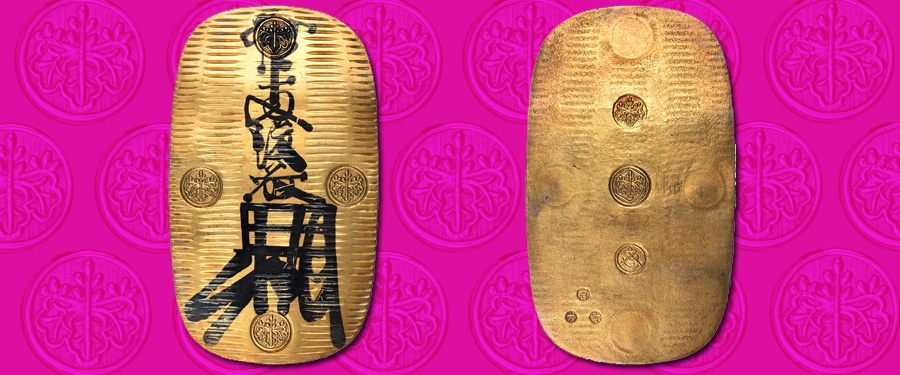
The Stack’s Bowers Galleries August ANA World’s Fair of Money catalogs
have now mailed and the entire sale can be viewed here. For this week’s preview
we have a large, fascinating piece of Shogun era Japanese currency. The Tokugawa Shogunate was a feudal
Japanese military government which followed the Japanese “Warring States”
period. For over 250 years the Tokugawa Shoguns ruled feudal Japan as autocrats
with the Samurai as the elite warrior-caste. This era was steeped in a strict class
hierarchy, and while the emperor acted as a religious and political leader, the
Shoguns held the military power and were ultimately more powerful than the
emperor.
The currency system of Japan before the Tokugawa Shoguns was dependent on
the Chinese bronze cash coinage. The founder of the Tokugawa Shogunate, Ieyasu,
established a gold, silver, and bronze denomination system that lasted until
the Meiji Restoration which ended the Shogunate’s rule. The largest
denomination in this coinage system was the “Oban” gold piece, which was
typically used as a special reward or gift rather than in day-to-day
transactions. The type offered in our August auction has the handmade crenulations
(the subtle grooving on the obverse face). This piece is from the Manen era,
the final period before the Meiji Restoration and after U.S. Commodore Matthew
Perry helped to end Japan’s isolationist policies under the Shogunate. This
ovoid gold plate piece features an obverse design bearing the Kiri Crest of the
Office of the Prime Minister of Japan. The symbol – or Mon – is the Paulownia
flower and is known as the Princess Tree in Japan. The symbol appears in the
12, 3, 6, and 9 o’clock positions. The beautiful luster on this coin draws the
eye to the stunning calligraphy at the center. An interesting feature of this
piece is its security edge, which prevents any unscrupulous individuals from
shaving or filing the coin. The reverse features the Paulownia flower Mon seal
punched in the center and one just above center. Below the center punch is
another Japanese symbol punch. The 7 o’clock position contains a triangle
design of three smaller punches as well.
Though similar in appearance these presentation issues can easily be
distinguished from their regular issue counterparts by the three control marks
on the reverse “Kenjo Dai Kichi” which as individual characters means
“Great, auspicious and Peace” and when put together in this manner mean
“Presentation” or “Contribution” Oban. These presentation
issues were made on the first day of the new year and were used for very
special occasions. This Oban is truly beautiful, a type known for the stunning
calligraphy on the obverse face. The inking on this particular piece is
original, as guaranteed for the Oban by the Japanese Numismatic Dealers
Association (JNDA). This lot includes an official JNDA certificate signed by
the president of the JNDA: Keiji Sako. The certificate is housed within a red
leather official JNDA holder, and the Oban is housed within a wooden display
case with a red velvet interior. The piece is estimated to be in Nearly Mint
State condition.
Though our Stack’s Bowers Galleries August ANA World’s Fair of Money
Auction is no longer open for consignments, we are now accepting consignments
of world and ancient coins for our January 2017 New York International Auction
as well as Chinese and other Asian coins and currency for our April 2017 Hong
Kong Showcase Auction. If you are interested in consigning your coins and paper
currency (whether a whole collection or a single rarity) be sure to contact one
of our consignment directors.





